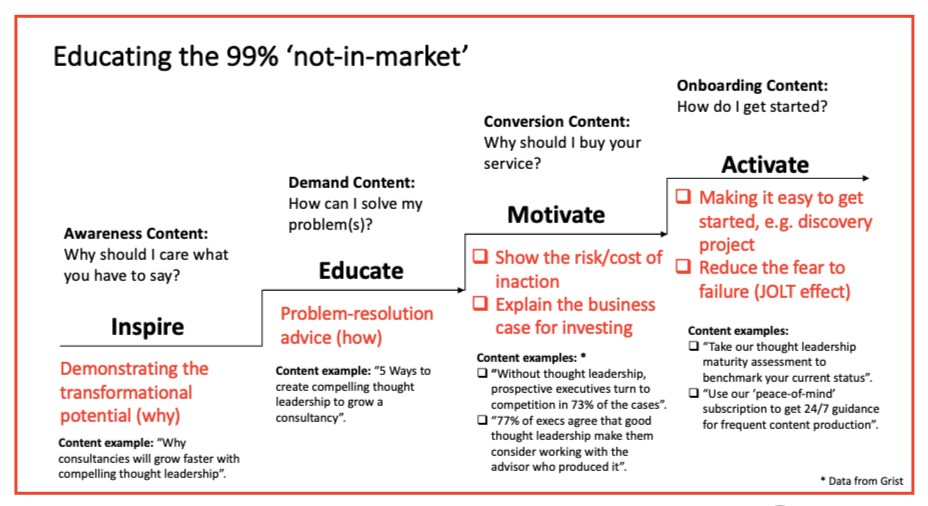
How Consultancies Can Reach the Unconverted Audience in 4 Steps
.jpg?width=56&name=francescorizzato8%20(1280px).jpg)
This article was last updated on 27 June 2023
“Luk, how are we supposed to convince those who are not actively looking to buy consulting services within our target audience to not just buy such services but do so from us?” This is a question that was posed to me during one of the training sessions I hosted earlier this year.
Indeed. How do consultancies increase their odds and activate those “not in the market”?
Are sales teams supposed to send bulk emails with sales brochures and wait until a couple of contacts bite? Are consultants supposed to call every contact they have and try to convince them to allocate a budget towards their consulting services?
No, of course not. Who has the time, the man power, or the patience for such low-ROI efforts!
The answer lies in educating the market and activating prospects through a gradual, 4-step thought leadership journey. I’ll elaborate on the steps in this post.
Step 1: Inspiring the audience through awareness content
At this initial stage, consultancies should maximize the level of market awareness of their expertise.
In practice, this means producing thought leadership content that gets the target audience’s attention.
The goal of the awareness-stage thought leadership: Why should the target audience care about what the consultancy has to say.
How this is achieved: Articles, webinars, speaking engagements, LinkedIn posts, and other content formats at this stage should demonstrate the transformational potential of certain actions.
Content examples:
- “Why consultancies will grow faster with compelling thought leadership”.
- “Why blockchain technology is essential to your supply chain operations.”
- “Why ChatGPT will rewrite the rules of search engine optimization (SEO).”
- “Why online retailers must embrace contextual commerce.”
- "How can adopting sustainable practices increase profit margins for manufacturers?"
- "What benefits can small businesses reap by embarking on a digital transformation journey?"
- "Why should consultancies prioritize the well-being of their employees to enhance productivity?"
Engaging the target audience is not easy. There are tons of pieces online. However, not everyone who produces content on a semi-regular basis can be called a “thought leader” or a subject matter “authority”. Far from it.
Truly valuable content helps the target audience look at their status quo from a different perspective. It doesn’t just list pain points. It places them in a larger context, showing why inaction will most certainly have detrimental results.
Buyers expect deep levels of expertise from consultancies. The way to demonstrate such expertise is not through a nicely designed brochure that provides a laundry list of services with a couple of generic testimonials sprinkled throughout.
It’s to let the target audience make up their own mind and come to the conclusion that the consultancy is indeed knowledgeable by generously sharing that knowledge.
Recommended reading: The Single Biggest Mistake Consultancies Make: Talking About Themselves
Step 2: Educating the audience through demand content
Alright. Let’s say a consultancy acquired some regular readers through its inspirational content in Step 1. There is some initial level of trust from the audience. They find the content engaging and interesting enough to allocate time on a regular basis to read/listen to it. Now what?
It’s time to back up the transformational potential of content pieces with practical suggestions.
The goal of the demand-stage thought leadership: How can the target audience solve their problems.
How this is achieved: Thought leadership pieces at this stage should offer problem-resolution advice.
Content example:
- “5 ways to create compelling thought leadership to grow a consultancy”.
- “3 ways to increase transparency in your supply chain using blockchain technology.”
- “7 ways ChatGPT will change the way users interact with search engines.”
- “These are the conversion rates to strive for with contextual commerce.”
- "How can a strategic approach toward sustainability improve your manufacturing operations?"
- "What is the step-by-step guide to successfully implementing a digital transformation in your small business?"
- "How can a well-being program improve your consultancy's performance and client satisfaction?"
Once potential buyers of consulting services are made aware of the transformational potential of taking certain actions, it’s time to equip them with a few tools and resources to actually initialize change.
“But Luk, why are we giving away the secrets? Why would they even need us afterwards!” The ever-present fear of making yourself redundant by being generous with your knowledge. Honestly, I have yet to come across a case where this strategy backfired.
I regularly share the “secrets of my trade”. I explain exactly which tools I use and how I use them. For example, in the post on content hacks, I share where I draw my inspiration for all my content work. These are things that every single consultancy can adopt in their own operations. In this post on the content machine, I explain which software I use, how I promote my pieces, how I recycle and repurpose them – step-by-step.
And guess what? This type of content has yet to discourage my target audience from reaching out to me.
It’s the opposite, in fact. These pieces, together with all the other content that I put out, allow me to develop and grow trust with my audience. They facilitate discussions. I’ve received countless emails and calls over the last few years from individual consultants and practice leaders wanting my opinion on how to adapt these strategies to their unique needs. I’ve received questions asking for further advice. I’ve received requests to help implement strategies.
By encouraging the target audience to get proactive about solving their pain points and offering a set of tools to do so consultancies achieve a massive win – they spark the need for action in their target audience. Any marketer and sales executive will attest to just how valuable this moment is!
Step 3: Motivating the audience through conversion content
Alright, so the audience is now mature enough to know that there is a problem and have a few ideas on how they can go about addressing them. Now is the time to solidify the need to address it in their minds.
You see, high-performance consultancies do not address just any problem. Their area of specialization is not picked at random. They are paid premium fees not to address any pain point.
They are successful because they identified a need that’s extremely high-return for their clients and they aligned their expertise with delivering that return at the highest level.
Oftentimes, it’s deep-seeded problems that are not visible on the surface. However, these furiously successful firms have the depth of expertise required to spot the symptoms. They educate their audience on why these symptoms speak to a more serious issue and guide them through the journey of discovering for themselves why failing to address these issues will have costly results.
The goal of the demand-stage thought leadership: Why should the target audience buy the consulting services?
How this is achieved: Thought leadership pieces at this stage show the risk/cost of inaction. They make a strong business case for investing.
Content example:
- “Without thought leadership, prospective executives turn to competition in 73% of the cases”.
- “60% of executives expect this supply chain function to be fully blockchain-operated within 5 years.”
- “These SEO strategies help news publishers foolproof their content strategy against the risks of ChatGPT.”
- “How this small ecommerce store increased its sales by 400% in 1 year using contextual commerce.”
- "Did you know manufacturers not investing in sustainability face a 60% higher risk of regulatory penalties?"
- "Are you aware that small businesses ignoring digital transformation risk losing 50% of their market share to competitors?"
- "Did you know that consultancies that do not prioritize employee well-being see a 30% higher turnover rate?"
The thought leadership example above? It’s an actual statistic from one of the best studies on the subject that I included in one of my pieces.
I urge consultancies in my pieces to change their way of thinking about marketing and business development and to start making changes now.
Having worked with a long list of firms, spoken to hundreds of consulting leaders, audited dozens of consultancies and consulting practices, I have acquired the experience and the knowledge to confidently state that the cost of inaction in terms of switching to an audience-education-based marketing strategy is the eventual demise of a business. It may not be today or tomorrow. But it will happen.
First it will become more difficult to get new clients. Then the pressure on each consultant and marketing executive to chase contacts will build up. Then the firm will start offering discounts and making all sorts of crazy accommodations to sign up a new client or retain an old one. This spiral continues until absolutely no one in the market has any idea what the firm is actually about and the business comes to a painful end.
This is not a made-up story I try to tell to scare my prospects into purchasing my services. It’s the reality that I actively try to help consultancies avoid.
It’s the consultancies’ job to spot problems before there is no turning back and help their clients adjust the course, coming out on the other end more successful, more efficient, or more profitable.
Recommended reading: Without Thought Leadership, Consultancies Will Fail
Step 4: Activating the audience through onboarding content
Alright, this is the ultimate step – signing up prospects.
By now, they are not only aware of the problem but are eager to address it. However, going all in all at once can be scary. Decision makers might be hesitant to start big. They want to first dip their toes in the water to see if it is indeed worth it.
Consultancies should make this step as easy as possible for their target audience. It’s about giving them the taste of the full potential.
The goal of the demand-stage thought leadership: How can the target audience get started.
How this is achieved: Thought leadership pieces should make it easy to get started and help reduce the fear of failure.
Content example:
- “Take our thought leadership maturity assessment to benchmark your current status”.
- “See how your supply chain tech stack compares to the Top 10 companies in the industry with this 3-day audit.”
- “Audit your links to see how many of your top performing pages risk significant drops in organic traffic over the next 3 months.”
- “Enter the keywords for your products to discover 20+ contextual commerce opportunities.”
- "Ready to embrace sustainability? Start with our free consultation to evaluate your manufacturing firm's current practices."
- "Want to drive digital transformation? Avail of our free introductory session to identify your small business's digital needs."
- "Looking to enhance your consultancy's performance? Use our free employee well-being assessment to identify areas for improvement."
This is the discovery stage of working with a prospect who is a soon-to-be client. Once a consultancy convinces prospects that there is a problem and it does require action, they should help these prospects understand the depth of the issue in their own organization.
Change is difficult. Uncertainty is scary. Business leaders and buyers are more wary about allocating budgets towards unplanned items – be it software or service purchases – than ever. Between the pandemic and the recession, the buyers need some sort of assurances.
That’s why it’s crucial that consultancies find a way to introduce prospects to the complete image of what the transformation will look like by first giving an easy way to take a glance.
This is also yet another brick in the foundation of building trust with the target audience. Instead of hitting them with the big sell, consultancies demonstrate that buyers can take a step back and turn around if they want. And many will. After all, no marketing strategy delivers a 100% conversion rate.
However, many will remain. Many will go through this journey and discover that they indeed have fundamental problems that need addressing. Because this particular consultancy helped them go through this journey, they will have trust in that firm and would want it to take their pain-ridden state and transform it into the “promised land”.
How the execution of the strategy looks in practice
Of course, the stages are not as synchronized as I outlined them in this post. Some prospects enter the journey at a more advanced stage. Firms also can’t set up systems where they split the stages and cover one for three months, another one for three months, and so on.
Rather, these are the types of thought leadership pieces and journeys that consulting firms should aspire to. For example, those who subscribe to the newsletter from a webinar page that presented content aligned with Step 1 goals should receive pieces related to that subject from Steps 2 and 3.
The steps are not always completed in this perfect manner. That’s why it’s so important that consultancies strive to develop a loyal audience by producing value-adding authentic content that, first and foremost, educates this audience. The more loyal readers/listeners/followers a firm has, the better it can control the journey.
It’s about nurturing trust and engagement. And that’s only possible when the efforts are consistent and the pieces that a consultancy produces address pain points of the target audience head-on.
In conclusion
I always say that not all content is thought leadership and not all thought leadership delivers equal results. That’s why I wanted to write this article – to show that thought leadership requires a deliberate strategy. It’s not about writing whatever comes to mind, but thinking through what the goal is and identifying steps to get there.
Firms can’t just always scream “You have a problem, you have a problem!” They need to guide their audience through the process of discovering it for themselves and showing them ways to start taking actions.
Interested in receiving all my learnings to become a better consultant? No spam, no BS. Pure teaching! Subscribe to my newsletter.
.jpg?width=66&name=francescorizzato8%20(1280px).jpg)
Luk’s extensive career in the consulting business, which spans more than 20 years, has seen him undertake a variety of influential positions. He served as the European CHRO for Nielsen Consulting (5,000 consultants in the EU), founded iNostix in 2008—a mid-sized analytics consultancy—and led the charge in tripling revenue post-acquisition of iNostix by Deloitte (in 2016) as a leader within the Deloitte analytics practice. His expertise in consultancy performance improvement is underlined by his former role on Nielsen's acquisition evaluation committee. After fulfilling a three-year earn-out period at Deloitte, Luk harnessed his vast experience in consultancy performance improvement and founded TVA in 2019. His advisory firm is dedicated to guiding consulting firms on their path to becoming high-performing firms, drawing from his deep well of consulting industry expertise and financial acumen.


